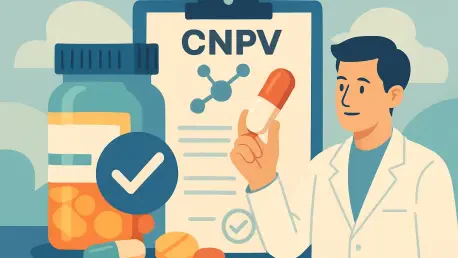In a world where patients often wait nearly a year for life-saving drugs to gain approval, a groundbreaking initiative by the FDA is slashing that timeline to mere weeks, promising a dramatic shift in biopharma. The Commissioner’s National Priority Voucher (CNPV) pilot program is not just speeding up reviews to 1-2 months for drugs addressing critical national needs—it’s redefining how biopharma operates. This seismic shift promises faster access to therapies, but at what cost to industry readiness? The stakes couldn’t be higher for companies racing to adapt, patients desperate for solutions, and a healthcare system under strain.
The importance of CNPV lies in its potential to align drug development with urgent national priorities like affordability, domestic manufacturing, and supply chain security. With drug costs soaring and global disruptions exposing vulnerabilities, this program offers a rare opportunity to address systemic challenges while accelerating innovation. Beyond faster approvals, it forces a reckoning within biopharma, demanding new strategies and unprecedented collaboration. Understanding this transformation is critical for stakeholders across the healthcare spectrum.
Why CNPV Matters in Today’s Landscape
The CNPV program arrives at a crucial juncture when the U.S. faces mounting pressure over drug pricing and reliance on foreign pharmaceutical supply chains. By prioritizing affordability and onshoring production, it tackles real issues—think skyrocketing costs for essential medications and delays during global crises. This initiative isn’t just about speed; it’s a strategic push to reshape how therapies reach the market while bolstering national resilience.
For biopharma companies, the implications are profound. The promise of a review timeline cut from 8-12 months to just 1-2 months means rethinking every step of the approval process. It’s a chance to deliver solutions faster, but only for those who can meet the program’s stringent demands. Patients stand to benefit most, gaining access to critical drugs without the agonizing wait that often defines their struggle.
This urgency extends to the broader healthcare ecosystem as well. Hospitals, payers, and policymakers are watching closely as CNPV could redefine access and cost dynamics. The program’s focus on aligning with national goals signals a shift toward a more integrated, responsive drug development framework—one that could set a precedent for future regulatory innovation.
The Driving Forces Behind CNPV’s National Focus
At its core, CNPV is built to address pressing challenges facing the U.S. pharmaceutical landscape. Affordability remains a top concern, with many Americans unable to access vital medications due to prohibitive costs. By tying accelerated approvals to pricing strategies that prioritize patient access, the FDA is nudging companies to rethink profit models in favor of societal impact.
Equally critical is the emphasis on domestic manufacturing. The program incentivizes onshoring to reduce dependence on foreign suppliers, a vulnerability laid bare during recent global disruptions. This push for U.S.-based production aims to strengthen supply chains, ensuring that critical drugs remain available even in times of crisis, while also streamlining inspections and scale-up processes.
Resilience in the face of uncertainty is another pillar of CNPV’s mission. By aligning drug development with these national imperatives, the initiative seeks to create a more robust pharmaceutical backbone. Companies that adapt stand to gain not just faster approvals but also a competitive edge in a market increasingly shaped by geopolitical and economic pressures.
CNPV’s Game-Changing Effects on Biopharma Operations
The CNPV program introduces a radical overhaul of traditional drug approval processes, demanding a shift to parallel execution over sequential models. With review times shrinking dramatically, regulatory, manufacturing, and commercial activities must now occur simultaneously. This requires tight coordination across functions, a challenge for firms accustomed to linear workflows, but a necessity to keep pace with the accelerated clock.
Pre-submission perfection has become non-negotiable under this framework. Critical elements like Chemistry, Manufacturing, and Controls (CMC) data must be finalized well before filing, leaving no room for mid-review corrections. Companies are forced to prioritize risk management and quality upfront, ensuring that submissions are airtight from the start—a high bar that tests even the most prepared organizations.
Beyond operational shifts, CNPV embeds affordability and onshoring as core mandates. Pricing strategies must reflect patient access goals, while incentives for U.S.-based manufacturing offer strategic advantages like easier FDA oversight. Enhanced agency collaboration through rolling reviews further sweetens the deal, particularly for generics and biosimilars, marking a new era where speed and societal value intersect in unprecedented ways.
Expert Perspectives on CNPV’s Opportunities and Hurdles
Industry voices highlight the dual nature of CNPV as both a breakthrough and a barrier. Henrik Johanning of Epista Life Science cautions that the compressed timeline reveals gaps in quality risk management, urging firms to adopt proactive readiness strategies. “It’s about sprinting before the race even starts,” he notes, emphasizing the need for meticulous preparation to avoid costly delays.
Metin Çelik from Pharmaceutical Technologies International advocates for integrated “war rooms” to manage the chaos of parallel tasks. His approach, involving weekly cross-functional reviews, ensures alignment across departments—a tactic echoed by others as essential for success. Meanwhile, Aloka Srinivasan of Raaha LLC hails enhanced FDA dialogue as a “game-changer,” especially for generics, offering a rare chance to iron out issues pre-submission.
Academic insights add depth to the conversation, with Sarah Emond and Daniel Ollendorf, in a Health Affairs Scholar piece, pushing for value-based pricing tied to patient outcomes. Rory Budihandojo, an independent GMP consultant, flags logistical nightmares like coordinating pre-approval inspections in weeks, not months. These diverse views paint an industry at a pivotal moment, grappling with speed while striving for precision.
Practical Strategies for Biopharma to Thrive Under CNPV
Navigating CNPV demands actionable steps tailored to its intense pace. Companies should adopt parallel workflow frameworks, restructuring operations so regulatory, manufacturing, and commercial efforts run concurrently. Establishing cross-functional teams with strong governance is vital to manage this complexity without sacrificing quality or compliance.
Front-loading CMC and quality readiness is another key tactic. Sponsors must complete tech transfers and risk assessments long before submission to avoid fatal delays. Similarly, integrating affordability into early strategy—through payer engagement and value-based pricing—aligns with CNPV’s goals, ensuring commercial plans don’t derail approvals.
Leveraging FDA communication offers a significant edge; pre-submission discussions should be treated as strategic opportunities to resolve potential roadblocks. Finally, investing in U.S.-based manufacturing, even for foreign firms, unlocks benefits like smoother inspections. These steps, grounded in expert advice, position companies to not just survive but lead in this transformed regulatory arena.
Reflecting on a Shift That Redefined the Industry
Looking back, the CNPV program stood as a turning point for biopharma, compressing approval timelines and aligning innovation with national needs. It challenged companies to overhaul outdated models, pushing them toward agility and collaboration in ways few anticipated. The impact on patients, who gained faster access to therapies, was undeniable, even as the industry wrestled with the demands of speed.
For those navigating the aftermath, the next steps involved sustained investment in parallel processes and domestic capacity. Building on CNPV’s framework, stakeholders had to prioritize early risk mitigation and affordability strategies to maintain momentum. Engaging with regulators proactively remained crucial, ensuring that the lessons of this initiative shaped a more responsive future.
As the landscape continued to evolve, the focus shifted to scaling these adaptations across broader portfolios. Exploring how such accelerated models could apply to emerging therapies offered a path forward. The journey sparked by CNPV laid a foundation for lasting change, urging the industry to balance rapid innovation with enduring responsibility.









